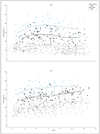Classification of body fatness by body mass index-for-age categories among children
- PMID: 19736333
- PMCID: PMC2846460
- DOI: 10.1001/archpediatrics.2009.104
Classification of body fatness by body mass index-for-age categories among children
Abstract
Objective: To examine the ability of various body mass index (BMI)-for-age categories, including the Centers for Disease Control and Prevention's 85th to 94th percentiles, to correctly classify the body fatness of children and adolescents.
Design: Cross-sectional.
Setting: The New York Obesity Research Center at St Luke's-Roosevelt Hospital from 1995 to 2000.
Participants: Healthy 5- to 18-year-old children and adolescents (N = 1196) were recruited in the New York City area through newspaper notices, announcements at schools and activity centers, and word of mouth.
Main outcome measures: Percent body fat as determined by dual-energy x-ray absorptiometry. Body fatness cutoffs were chosen so that the number of children in each category (normal, moderate, and elevated fatness) would equal the number of children in the corresponding BMI-for-age category (<85th percentile, 85th-94th percentile, and > or =95th percentile, respectively).
Results: About 77% of the children who had a BMI for age at or above the 95th percentile had an elevated body fatness, but levels of body fatness among children who had a BMI for age between the 85th and 94th percentiles (n = 200) were more variable; about one-half of these children had a moderate level of body fatness, but 30% had a normal body fatness and 20% had an elevated body fatness. The prevalence of normal levels of body fatness among these 200 children was highest among black children (50%) and among those within the 85th to 89th percentiles of BMI for age (40%).
Conclusion: Body mass index is an appropriate screening test to identify children who should have further evaluation and follow-up, but it is not diagnostic of level of adiposity.
Figures

References
-
- Freedman DS, Mei Z, Srinivasan SR, Berenson GS, Dietz WH. Cardiovascular risk factors and excess adiposity among overweight children and adolescents: the Bogalusa Heart Study. J Pediatr. 2007;150(1):12. e2–17.e2. - PubMed
-
- Berenson GS, Srinivasan SR, Bao W, Newman WP, III, Tracy RE, Wattigney WA. Association between multiple cardiovascular risk factors and atherosclerosis in children and young adults: The Bogalusa Heart Study. N Engl J Med. 1998;338(23):1650–1656. - PubMed
-
- Freedman DS, Khan LK, Serdula MK, Dietz WH, Srinivasan SR, Berenson GS. The relation of childhood BMI to adult adiposity: the Bogalusa Heart Study. Pediatrics. 2005;115(1):22–27. - PubMed
-
- Must A, Jacques PF, Dallal GE, Bajema CJ, Dietz WH. Long-term morbidity and mortality of overweight adolescents: a follow-up of the Harvard Growth Study of 1922 to 1935. N Engl J Med. 1992;327(19):1350–1355. - PubMed
Publication types
MeSH terms
Grants and funding
LinkOut - more resources
Full Text Sources
Medical

